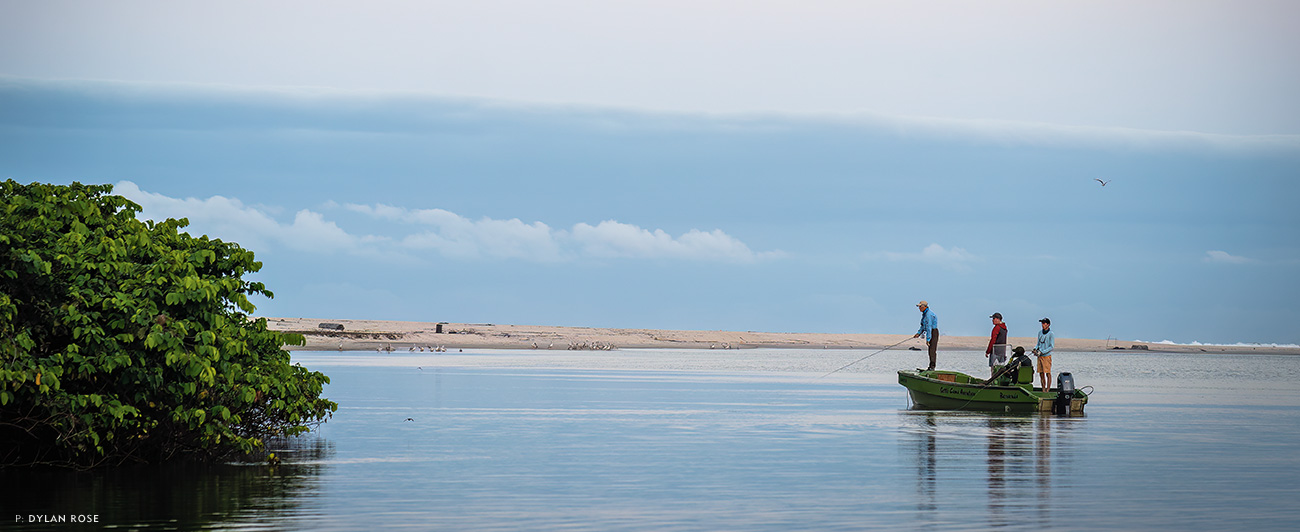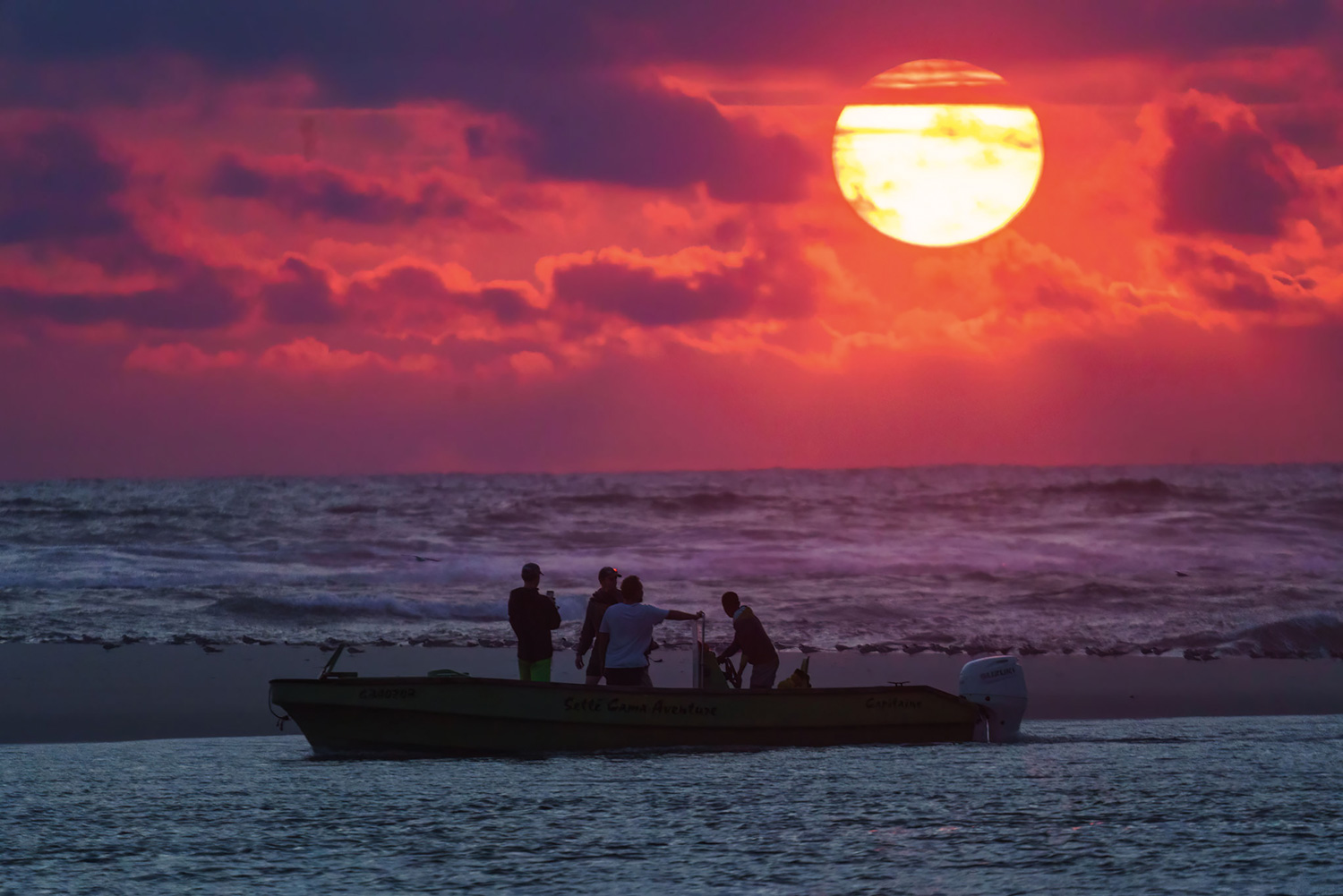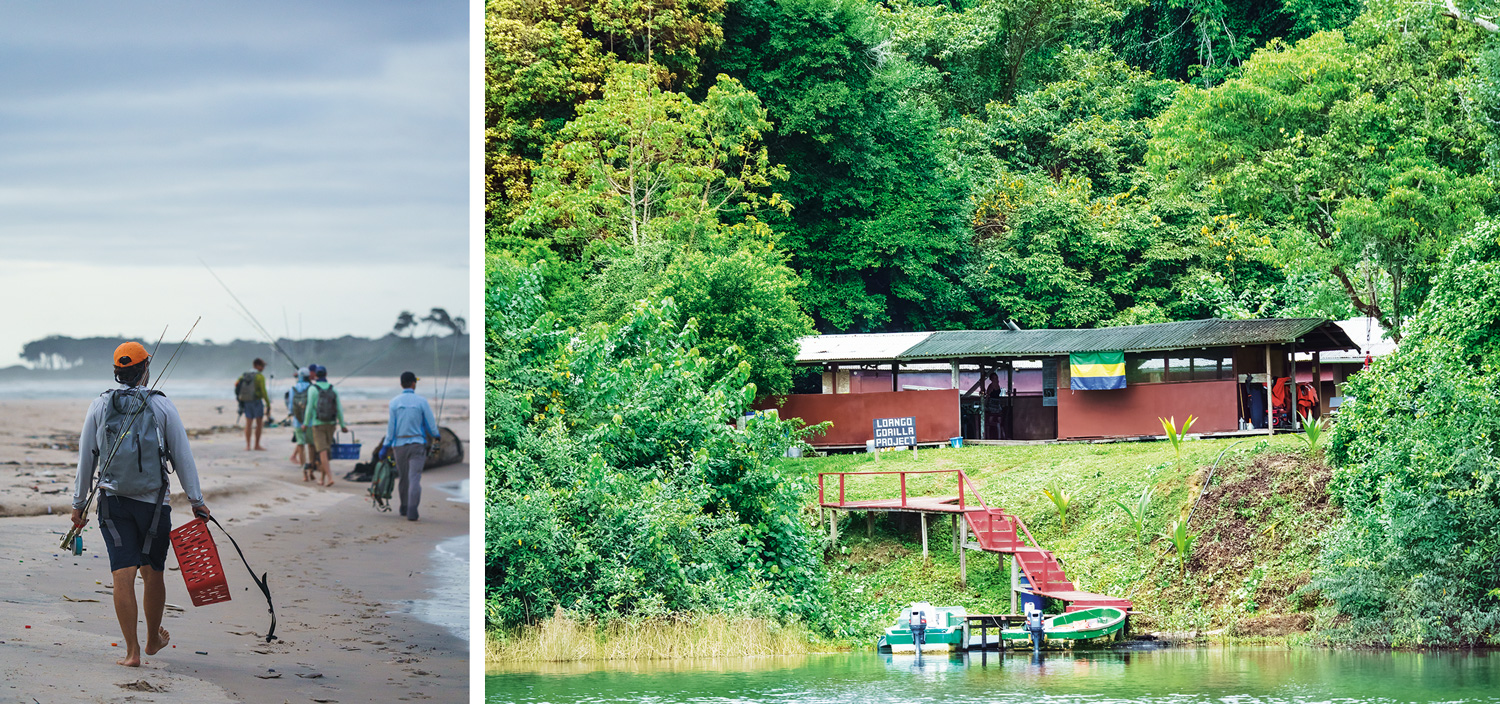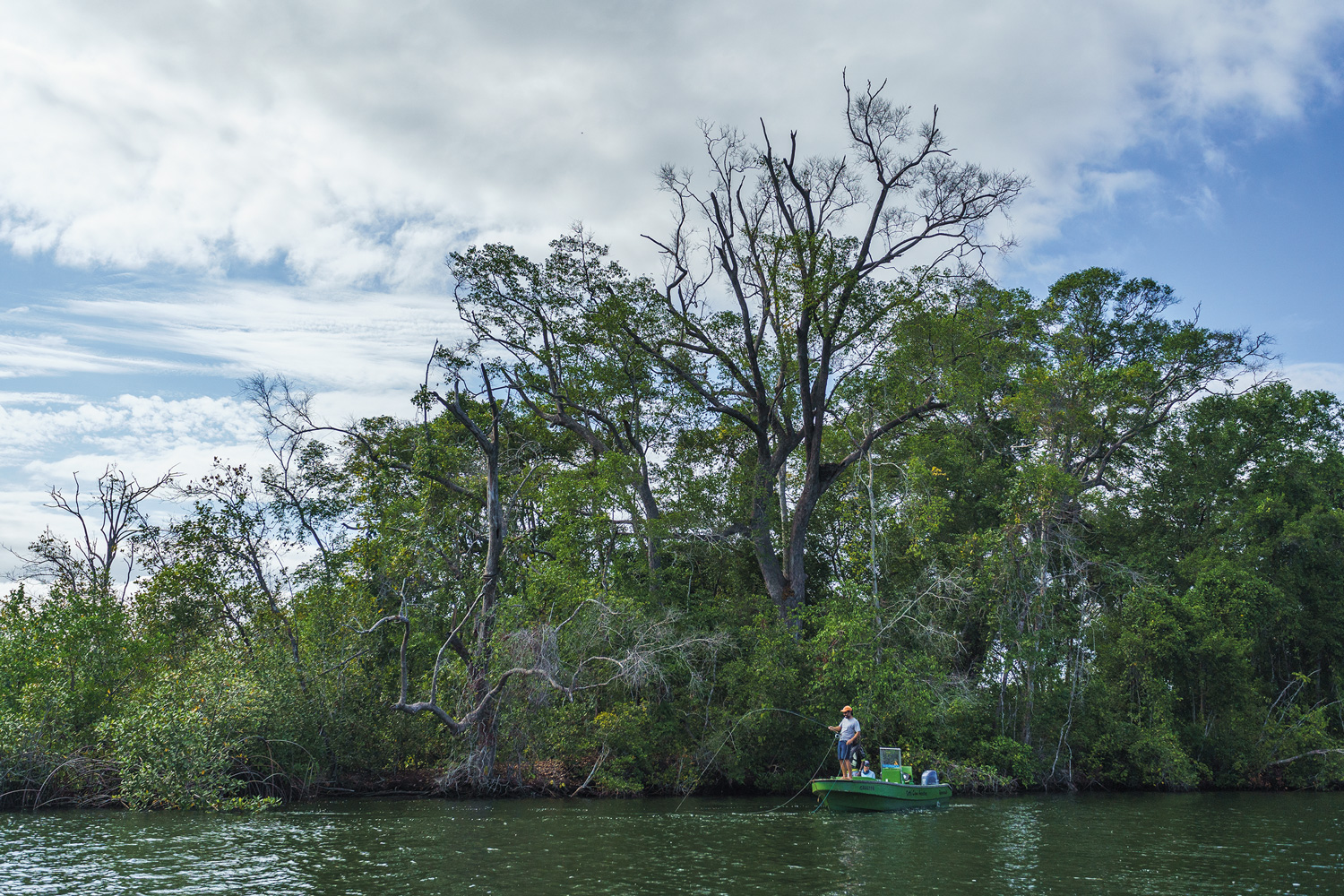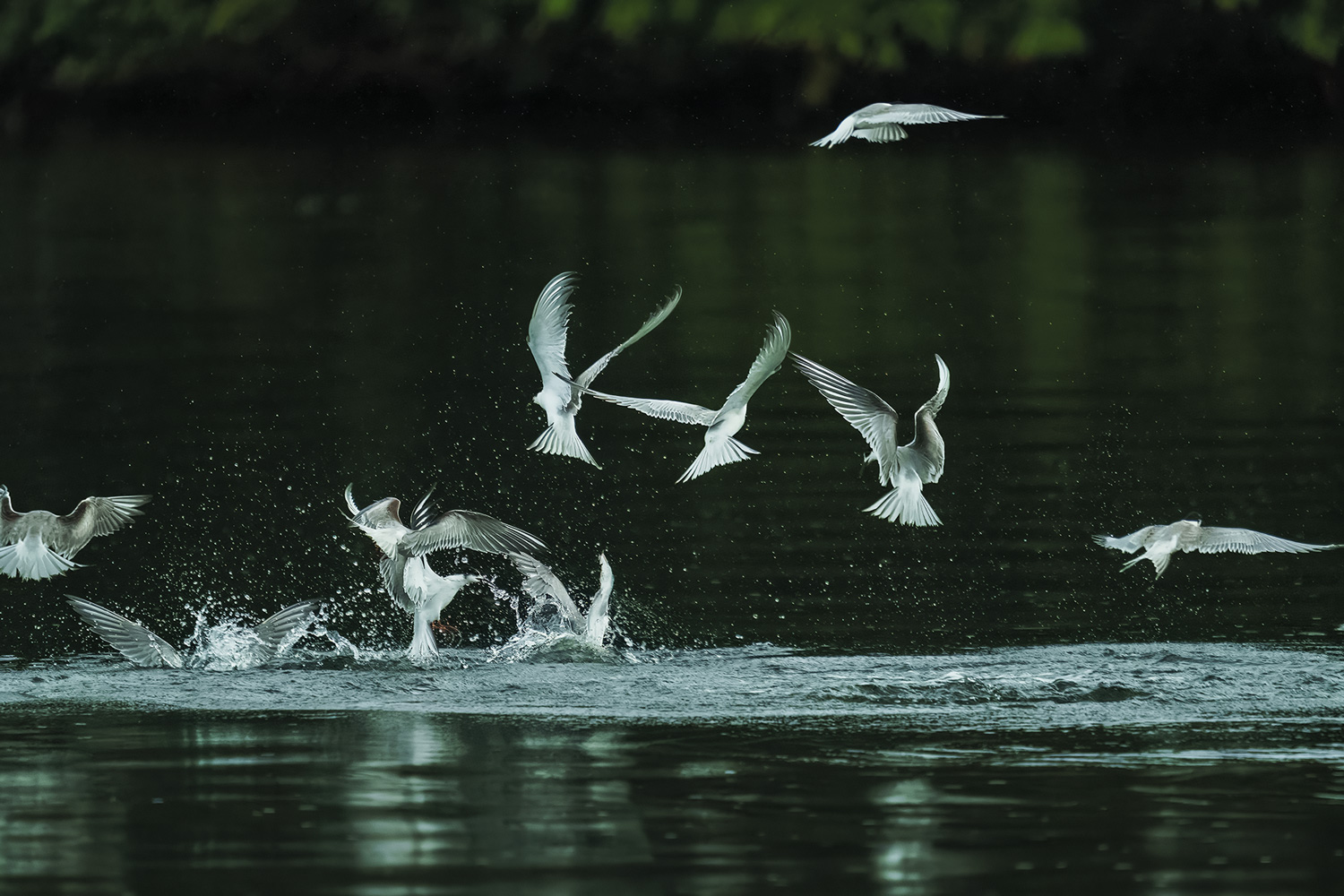Travel
Gabon
Endless Dopamine: 1,001 Ways to Live in the Gabonese Republic
First published in Volume 14, Issue 4 of The Flyfish Journal
The African night stretched to infinity beyond the tip of my 12-weight. Our fourth night wading this untamed beach had yielded nothing but a steady stream of blood leaking from my right heel, the rich plasma broadcasting my presence to patrolling sharks like an overzealous waiter trying to sell the evening special.
“Hey Teddy,” I said. “One of those damn snail shells sliced my heel open.”
Teddy replied, unfazed, “Just bury your foot in the sand, mate, and keep casting. The tarpon will show soon.” Teddy Coulter is the head guide at African Waters’ camp in Sette Cama, Gabon. He is a passionate native Irishman that grew up in South Africa, and he was hell-bent on watching us get wrecked by massive tarpon from the beach. As the inky black waters of the Ndogo Lagoon lapped at my waist, Teddy scampered off into the night. I pondered how best to tell my wife I’d lost a leg to a bull shark.
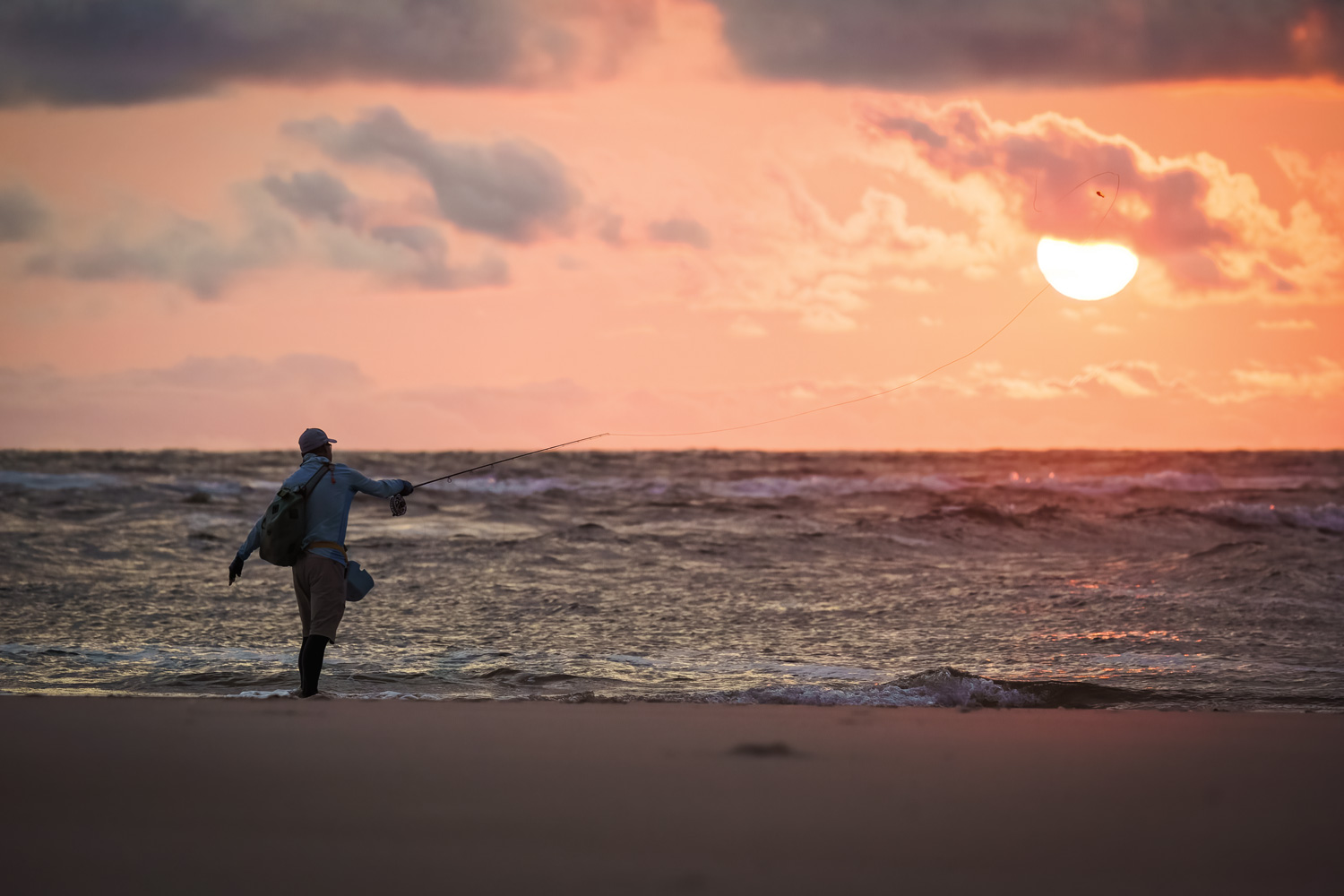
above Tim Lewis casts his 12-weight into the Atlantic Ocean as the sun sets on another adventure-packed day in Sette Cama, Gabon. When darkness falls, the predators activate. Our crew of anglers met the approaching dusk each evening with both apprehension and the thrill of large saltwater species activating for an evening’s feed.
My traveling companion, Tim Lewis, is from Seattle. Good natured and positive at every turn, Tim is a seasoned angler who regularly patrols the beaches of Puget Sound, WA, blind-casting endlessly for cutthroat and salmon. The evening prior Tim had hooked into a behemoth cubera snapper that finally cut him off on the rocks after a brutal and longwinded battle. His description after the melee was, “This is like Puget Sound—on pure crack.” He was just close enough that I could make out his silhouette, a comforting presence on a remote and wild African beach.
Through the darkness, skimming mullet slurping at the surface pattered like rain on a roof. A quick peek with my headlamp revealed a staggering field of them as far as the light would shine. As instructed, I quickly flipped the light back off: the large fauna swimming at my feet were easily put off by it. The occasional thunderous clap of slashing Guinean barracuda punctuated the steady drip of munching mullet. Larger—but less frequent—surface explosions rang out that were undoubtedly the attacks of tarpon as long as your couch. Louder still, cubera snapper trounced the mullet with the sound of bowling balls hitting the lagoon. Back in the jungle, two mongooses decided they’d had enough and were loudly setting things straight in the bush. I was alive in every sense of the word. All around me animals were eating each other.
We were in Loango National Park, in the west African Gabonese Republic just south of the equator. Accessible from the small village of Sette Cama, this prolific saltwater estuary and massive lagoon system drains into the Atlantic. It is fed by a pristine jungle ecosystem that remains utterly untouched and is home to Gabon’s “big five” game animals: gorillas, forest elephants, mandrills, chimpanzees and hippopotamuses. Spellbinding biodiversity explodes around the banks of the lagoon and at any moment encounters with elephants, forest buffalos or hippos are possible. Massive leatherback turtles nest there, while dolphins, humpback whales and Nile crocodiles abound. In places, the jungle rises 150 feet from the lagoon’s edge in an explosion of mature hardwoods, vines, verdant foliage and fruiting trees that harbor a persistent chorus of bird and insect life. When the moniker “Africa’s Eden” was coined, this is the place they were talking about.
Gabon sees about 137 inches of rain per year; for perspective, the “rainy” city of Seattle sees about 33 inches annually. As the endless water falls on the biomass of the rainforest, a flood of nutrients, forest detritus and minerals inundate the lagoon and spark a cascading plume of life near the bottom of the food chain that begins with hordes of mullet and various other baitfish. The fishery offers a dynamic wading experience where the lagoon enters the Atlantic, with the fish coming alive just as the sun begins to set. Senegalese kob, Guinean barracuda, African threadfin, tarpon and finally bull sharks make quick work of the mullet, a complex web that compresses at the mouth of the lagoon as currents trap and condense the prolific masses of bait.
Back on the beach, we made cast after cast into the black of night. With each attempt, visions of 200-pound tarpon, snapper the size of Vespas, huge African threadfin and silver-gilded Senegalese kob danced in my head. Lift, haul, forward, back and launch. Did it lay out straight or did I smack the beach behind me and manage a 20-foot mess? In the dark it was a guessing game. Cast after cast, I blindly sailed my brush fly forward, every tactile input of the rod in motion magnified. The feel of the rod being pulled laterally meant an ill-tracked cast. The line streaming out with pace and a satisfying clip as everything came tight to the reel was temporary bliss, enjoyed only for the thrilling moments of stripping in the line before mustering the gumption to do it all again. My thumb and wrist were numb with pain, but I had found my groove.
I pondered how best to tell my wife I’d lost a leg to a bull shark.
clockwise from top left
Philippe Gouzer and Teddy Coulter rig rods at midnight at the mouth of Ndogo Lagoon. Fishing in complete darkness for large and powerful saltwater species offers a unique set of challenges and maxes out the adventure meter.
Myriad smaller snapper species—including brown, striped, cubera and Guinean—are available in Ndogo Lagoon and they’re good fun on poppers and small baitfish patterns.
Anglers at the mouth of Ndogo Lagoon pause at the sight of the falling sun over the Atlantic. There is just something different about west African sunsets. They seem bigger, more intense, wonderous and even somewhat foreboding.
With the sound of the raging Atlantic thumping in my ear drums, the disorienting and muggy cloak of night finally yielded a willing participant. I stripped the fly into something heavy and the familiar pulsing chaos ensued—the line sped away and my heart rate spiked. Hooking a fish at night ratchets up the intensity. Far in the distance I heard the unmistakable slap of a tarpon’s body slamming into the water. After a short tussle, my first African tarpon came to hand. It was small by Gabonese standards, but I was thrilled. In the next hour I hooked into three more runaway freight trains. The sheer weight and power of these fish is not easily described. They may have been tarpon, supersized cubera or even 1000-pound bull sharks. I’ll never know. Each one pulled free or broke off with the help of a strong ebb that took them back to the Atlantic unfettered.
After the third such loss, I vowed to stick the next fish even harder. I locked the drag down and decided I’d either land one of these brutes or break something trying. Unfortunately, I’m a man of my word. On the next take, the fish yanked the line out of my stripping hand. When I regained control, I set with my left while pulling the rod hard and deep to my right to bring the hook home. The fish sulked and held in the current 30 feet away from me and I thought, I’ve got you now.
The fish, unaware that there may be a problem or simply unconcerned, gave me a moment to switch on my headlamp. Then it came alive. It tore the line free of my pruney stripping hand and a loop of line hopped into the air and wrapped itself around my rod and stripping guide. I looked up in terror and caught a glimpse of a gigantic tarpon attempting to heave its massive body out of the water. The front half of the fish cleared the surface and thrashed back and forth. For a disjointed moment, its girth reminded me of the 40-inch flat screen TV hanging on the wall in my living room back home. Then it slammed back down and the fly line snapped with the report of a .22 caliber round going off inside my ear. The subsequent concussion of the 50-pound core line parting separated my rod at the second ferrule and the top two sections were lost to the lagoon. The fish of my dreams was gone.
left to right
Anglers unload skiffs and get ready for the night session at the mouth of Ndogo Lagoon. This prolific estuary is home to some of the largest tarpon found on Earth, as well as massive cubera snapper, Guinean barracuda, African threadfin, longfin jacks and Senegalese kob.
The Loango Gorilla Project is based in a remote section of Loango National Park and funded in part by the Max Plank Institute for Evolutionary Anthropology. This rustic, remote camp is the launching point for setting out into the park with pygmy trackers to observe wild western lowland gorillas.
The lagoon itself sits on the southern border of the park, recently made famous by its surfing hippopotamuses in the Netflix documentary Our Great National Parks. Gabon is home to the largest population of wild forest elephants of any country in the world and the largest intact habitat of the species’ range. Some 96,500 square miles of jungle lay intact for the elephants, which represents 90% of the country’s territory. In 2002, then-President Omar Bongo set aside 13 national parks, encompassing nearly 11 percent of the country’s total land area. This is among the highest percentage of designated national park land of any country in the world.
While on the beach, I spent hours peering into the edges of the jungle. Hippos, elephants, chimpanzees, gorillas, forest buffalo, jaguar and a Pandora’s box of creepy crawlies exist in healthy populations in Loango National Park. Though I eventually got the chance to satisfy my curiosity with a 10-mile trek deep into the park’s heart, my first steps into the forest came with both excitement and a healthy dose of trepidation. Stories abound of the 1,001 ways to die in an African jungle; among the highlights are parasites, swarming Tsetse flies, insanely venomous snakes, aggressive elephants and even a lion caught on a camera trap.
I looked up in terror and caught a glimpse of a gigantic tarpon
attempting to heave its massive body out of the water.
clockwise from top left
The cubera snapper is one of the most sought after and well-respected species at Sette Cama. Built with an intimidating set of razor-sharp teeth that protrude from their mouth and a propensity to lodge themselves into rock caverns after being hooked, they are formidable. Their power is unmatched among snapper species and this fish elicited a chorus of whoops, hollers and accolades from the crew for Tim Lewis’ success.
Tim Lewis displays a chunky cubera snapper that nearly became the-one-that-got-away. The fish buried itself in the rocks twice, but with some handy work from guide Teddy Coulter and perseverance from Tim, we got to spend a moment with it before release.
A hippopotamus displays his weaponry deep in the heart of Loango National Park. Their mouths open to nearly 180 degrees as a warning to stay away. Rather surly by nature, it’s wise to give them plenty of space and admire their fascinating adaptations from a safe distance.
An agama lizard hunts for insects at camp in Sette Cama.
An African forest elephant splashes mud on her back to keep the vicious Tsetse flies away. Theses elephants are generally smaller and more mild-mannered than their savanna cousins. However, spending time in their presence was no less awe-inspiring. We made a hasty retreat—i.e. a full clumsy run through the bush—shortly after this image was taken, as she let us know we were no longer welcome.
Every nook and cranny of the jungle was alive. The trail was the only serviceable way through the fortress of vines, downed trees and the matrix of branches and foliage. It was clear that while we were utilizing the pathway, others clearly did as well. Elephant tracks left deep imprints in the mud and their dried feces was covered in microfauna as it slowly assimilated back into the environment. Overhead, troops of mangabey monkeys streamed through the canopy, screeching in dismay at the ridiculous notion that we dared wander into their neighborhood. Bird calls echoed through the trees in stereophonic high-fidelity, coming from everywhere all at once, the birds impossible to see against the dark canopy. The blistering buzz of insect life wailed on beneath it all.
Our Gabonese wildlife guide, Pierre, warned me (too late) not to step on the army ants. Just as I started to believe that my trail-runners and thick wool socks would keep me safe, I began to feel the stabbing pain of miniscule knives entering my calves, inner thighs and scrotum. I pressed on swatting at my pants, doing the actual ant-dance and shaking myself in an effort rid the angry devils from my drawers. The sounds, smells, humidity, subdued light and all-encompassing adventure forced a broad smile across my face. After a travel-drought for the better part of two-and-a-half years due to the pandemic—and a good portion of it spent in lock down—it felt good to be out of my element, testing my nerves and experiencing raw adventure again.
The trek through Loango brought me face-to-face with a host of forest elephants, including a charging mother that required a hasty escape. We crossed paths with forest buffalo, sitatunga antelope, red river hogs, Nile crocodiles, hippopotamuses and monitor lizards. On the journey, we met a true gentleman and former officer in the British military named Rupert Litherland who joined us every step of the way. Rupert cataloged and positively identified over 100 species of birds, a fascinating accomplishment for any devout birder on a single trip. However, none of that would compare to staring into the eyes of a 400-pound western lowland gorilla.
left to right
Kamaya is the resident dominant silverback of the Atananga Group of western lowland gorillas, found in Loango National Park. Luckily for us on this day, he was peacefully munching on leaves, napping and enjoying some time with his family.
Ipikilia is the youngest member of the Atananga gorillas. At six months old, she had only just begun to venture away from her mother, a few feet at a time. Her endless energy to climb, pull on branches, grab foliage and genuinely annoy her mother was eerily reminiscent of a human toddler.
I did my best to keep up with the steady pace of our pygmy trackers. Prior to the trek, a scientist for the Loango Gorilla Project set aside time to tell us about the pygmy people—the earliest inhabitants of Gabon—and their relationship with the gorillas. They were largely absorbed by the Bantu people who settled the region and now comprise about 40 peaceful tribes living in Gabon and the surrounding central African region. The pygmies, with an average adult height of about five feet, are noted for their tracking, hunting and gathering abilities to this day, with many finding reliable work with tourism organizations such as the Loango Gorilla Project.
Much of the work of the project, supported by the Max Planck Institute for Evolutionary Anthropology, revolves around habituating the gorillas to humans, work that is done in large part by the pygmies native to the area. Through habituation, the gorillas and their interactions with the ecosystem can be studied in greater detail, and tourism opportunities can provide much-needed funding for their protection and preservation. The process of habituation is painstaking and can take years; it involves gradually building trust with the resident silverback of the group. The pygmies grow deep bonds with the gorillas and intimately know their personalities, tendencies and family histories.
When we wandered off trail, the trackers marked the way with snapped saplings and communicated with radios. Their effortless movement through the raw forest came easy and quiet, while I stumbled on roots and clumsily swung a 600mm lens from my neck. Finally, after trekking several miles from camp, their pace slowed to a crawl and then a full stop. The guide turned and looked at me, drawing my attention beyond his right shoulder. Not 30 feet away, an immense black shape watched us through the trees.
There are no words, no clever prose, nothing in the world that can prepare you for standing mere feet from a silverback gorilla. His name was Kamaya and his eyes peered into mine, a peaceful yet dominant expression that revealed an intelligence equal to my own. My heart pounded and I stood statue-like, afraid to move a muscle. I tried to remember all the stern rules from the safety briefing regarding how to behave in Kamaya’s presence. Don’t look him in the eye, don’t break or shake any branches, don’t challenge him in any way, and above all do not move a muscle if he charges at you screaming and breaking trees in half. Luckily, he was in a welcoming mood, which—as I was told by the scientists who joined our trek that day—is not always the case. As the minutes ticked by the anxiety lessened, and an easy and extreme sense of wellbeing set in. I calmed my breath, realized the gravity of the moment, and began taking images.
I tried to remember all the stern rules from the safety briefing regarding how to behave in Kamaya’s presence. Don’t look him in the eye, don’t break or shake any branches, don’t challenge him in any way, and above all do not move a muscle if he charges at you screaming and breaking trees in half.
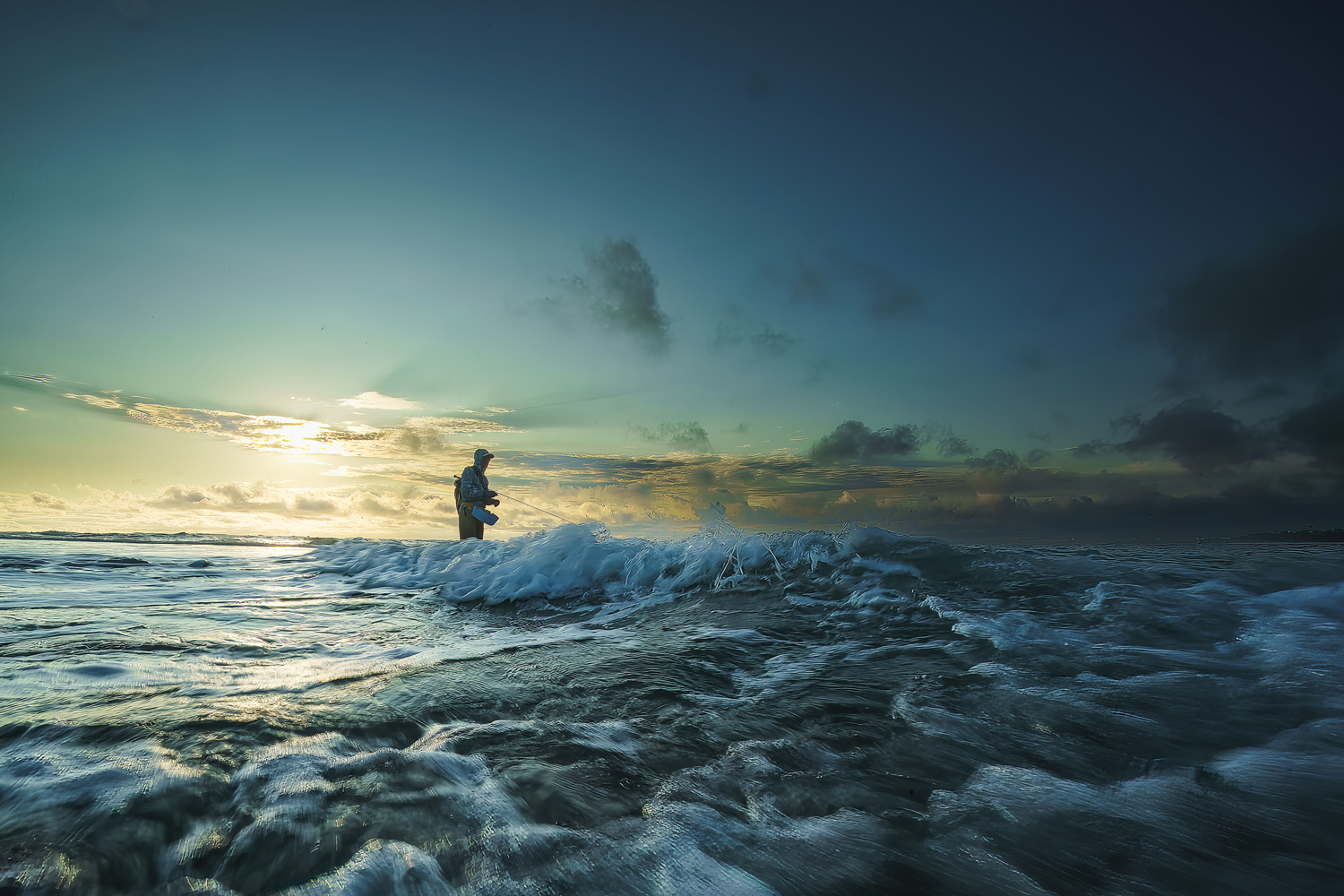
above Tim Lewis makes a two-hand retrieve as the sun sets on our wild African experience. There is so much possibility with every cast when standing on an African beach. It seems as if your heart rate never reaches full resting rate until you are firmly back home.
Kamaya’s family slowly revealed themselves, emerging from the bush out of nowhere. As Kamaya laid down for his afternoon nap, I focused on the two youngsters in the family. They climbed endlessly, prodding their mothers and living the gorilla dream. One of them, named Ipikilia, was only six months old. For a moment, he ventured a few feet from his mom and our guide whispered that it was the first time they’d seen him do this. I battled fogged lenses, the dark, dripping understory and his constant movement to try and get a clean shot. Ipikilia and his sibling played, munched on foliage and lounged around, content and happy.
They live on their own terms, go where they choose, fight their own battles (mostly with chimpanzees), and go through the process of painstaking habituation by scientists and trackers. For me, the world is a better place knowing that Kamaya and his family are tucked away in the protected wilds of Loango and afforded the chance to simply go on doing gorilla things.
clockwise from top left
A longfin jack comes to hand after a lengthy fight. Just as it seems they are ready to give up, you find yourself groaning as your line slips away and the fish tears into your backing once more.
The longfin jack is a bruising, hard fighting character with unrelenting power. Like its cousin the jack crevalle, these fish smash flies with a power that belies their true size. As they roam the lagoon in marauding packs, they terrorize unfortunate balls of mullet and baitfish that cross their path. A fly thrown into a writhing mass of fish nearly always yields a strike with double hookups more the rule than the exception.
Michael Gumener hooked up to a snapper along the banks of the lagoon. Its brushy banks are home to many large fish and are a surface fly angler’s dream.
The endless dopamine drip that is Africa is all encompassing and addicting. Everything was more intense—the encounters, colors, smells and beauty ratcheted up a notch further than I’d ever experienced. Gorillas, hippos and elephants are the fantastical animals of our youth, and yet here I was truly seeing them for the first time: the way a hippo’s eyes perch perfectly above the waterline while their massive bodies hover weightless underneath; the sandy substrate of a Nile croc’s nesting ground beneath your toes; the immaculately striped sitatunga blending into a jungle of vines and branches. An elephant’s trunk suddenly makes perfect sense when you see it moving branches out of its way to clear a path or gathering mud to splash on its back.
There is a deep satisfaction in seeing a creature like a gorilla in the wild, outside of a zoo, peacefully munching on leaves and enjoying its family despite the world raging around it. We turn to fishing for much the same experience—standing with a rod amidst a pristine wilderness where humans are regularly challenged for their place in the food chain. Everything is larger than you and more powerful and features nastier teeth. To even approach it all with fly tackle is a lesson in insanity; however, the draw to land one of these creatures on a fly while standing on the beach is too alluring to pass up.
When I met Rupert early in the trip it was clear his vast experience in the military and British intelligence had exposed him to adventures through nearly every corner of the globe. However, it was Africa that always left him yearning. As he said one day, “If I go too long without a dosage of Africa, I find I’m not quite the same person.”
An elephant’s trunk suddenly makes perfect sense when you see it moving branches out of its way to clear a path or gathering mud to splash on its back.
above With screeching terns above and bands of ferocious longfin jacks below, Ndogo Lagoon is not a fun place to be a mullet or baitfish. The crashing birds make finding schools of bait and jacks easy, and this scene is almost always followed by a near instantaneous hookup.
